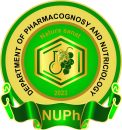- Give the definition of the term “phenolic compounds”.
- Write the classification of phenolic compounds (class of the compounds according to the number of carbons and examples of structures to each of the classes).
- How are the simple phenolics classified? Give examples of structures.
- Describe physical and chemical properties of simple phenolics.
- Describe the identification of simple phenolics (reagent used – result obtained).
- Describe the types of pharmacological activity of simple phenolics.
- How can bearberry and cowberry leaves be distinguished?
- Give the definition of the term “coumarins”. Write the general structure of a coumarin.
- Write the classification of coumarins with examples of structures.
- Describe physical and chemical properties of coumarins.
- Describe the identification of coumarins (reagent used – result obtained). Write the chemical reaction of azocoupling and lactone tests.
- Which methods are used for quantitative determination of coumarins?
- Give the definition to the term “chromones”. Write the general structure of a chromone.
- Write the classification of chromones with examples of structures.
- Describe physical and chemical properties of chromones.
- Which types of pharmacological activity do coumarins and chromones have?
- Give the definition of the term “lignans”. Write the classification of lignans, their physical and chemical properties, identification and quantitative analysis methods. Which types of pharmacological activity do lignans have?
- Give the definition of the term “xanthones”. Write the classification of xanthones, their physical and chemical properties, identification and quantitative analysis methods. Which types of pharmacological activity do xanthones have?
- Give the definition of the term “flavonoids”. Write the classification of flavonoids with examples of structures.
- Write the classification of true flavonoids with examples of structures.
- Write the classification of isoflavonoids with examples of structures.
- Describe physical and chemical properties of flavonoids.
- Describe the identification of flavonoids (reagent used – result obtained). Write the chemical reaction of cyanidin test.
- Which methods are used for quantitative determination of flavonoids?
- Describe the main types of pharmacological activity of flavonoids.
- Write the Latin name of the medicinal plant material, plant and family of the plants which are the sources of vitamin P.
- Write the Latin name of the medicinal plant material, plant and family of the plants which are the sources of anthocyanidins.
- How can water pepper and redshank be distinguished?
- Give the definition of the term “anthraquinone”. How are the anthraquinones classified?
- Write the classification of monomer anthraquinones with examples of structures.
- Write the classification of dimer anthraquinones with examples of structures.
- Describe physical and chemical properties of anthracene derivatives.
- Which methods are used for identification and quantitative determination of anthraquinones?
- Which types of pharmacological activity do anthracene derivatives have?
- What is the correlation between structure and pharmacological effect of anthraquinones?
- How can alder buckthorn and common buckthorn be distinguished?
- Give the definition of the term “tannins”.
- Write the classification of tannins.
- Describe physical and chemical properties of tannins.
- Describe the identification of tannins (reagent used – result obtained).
- Which methods are used for quantitative determination of tannins?
- Which types of pharmacological activity do tannins have?
- Write the Latin name of the medicinal plant material, plant and family of the plants which are the industrial sources of tannins.
MICROSCOPICAL DESCRIPTIONS
SIMPLE PHENOLS: Bearberry: 1 – upper epidermal cells; 2 – lower epidermal cells; 3 – stomata; 4 – simple hairs (rarely found at the base of young leaves);
Cowberry: 1 – epidermal cells; 2 – stomata; 3 – gland with brown contents;
FLAVONOIDS: Motherwort: 1 – upper epidermal cells; 2 – lower epidermal cells; 3 – stomata; 4 – glandular hair; 5 – simple multicellular hair; 6 – essential oil gland;
Water pepper: 1 – upper epidermal cells; 2 – lower epidermal cells; 3 – stomata; 4 – colourless or brown glands; 5 – bundle of hairs at the leaf margin; 6 – druses; 7 – essential oil glands;
Redshank: 1 – upper epidermal cells; 2 – lower epidermal cells; 3 – stomata; 4 – essential oil gland; 5 – bundleof hairs on all the leaf blade; 6 – druses;
Tickseed: 1 – upper epidermal cells; 2 – lower epidermal cells; 3 – stomata; 4 – simple, caterpillar-like, hairs with brown contents; 5 – rosette at the base of a hair; 6 – simple thick-wall hairs at the leaf margin and along the veins; 7 – secretory passages with brown contents along the veins;
Restharrow: 1 – radial structure: phloem and xylem elements are situated in narrow radial bundles; 2 – wide medullar rays; 3 – large parenchymal cells; 4 – bast fibers; 5 – cambium; 6 – xylem vessels; 7 – tracheids; 8 – libriform; 9 – prismatic crystals of calcium oxalate;
ANTHRAQUINONES: Alder buckthorn: 1 – cork layer; 2 – collenchyma; 3 – parenchymal cells of outer bark; 4 – druses; 5 – mechanical fibres; 6 – medullar rays; 7 – groups of bast fibers surrounded by crystals;
Rhubarb: 1 – cork; 2 – phelloderm; 3 – medullar rays; 4 – cambium; 5 – parenchymal cells with starch grains; 6 – druses; 7 – xylem vessels; 8 – starch grains;
Senna: 1 – epidermal cells; 2 – rosette at the base of a hair; 3 – simple hairs with warty cuticle; 4 – stomata; 5 – druses; 6 – vein with crystal sheath;
St. John’s wort: 1 – upper epidermal cells; 2 – lower epidermal cells; 3 – stomata; 4 – receptacles with red-violet pigment; 5 – colourless receptacles;
TANNINS: Oak: 1 – multilayer cork; 2 – druses; 3 – stone cells; 4 – mechanical bundle; 5 – groups of bast fibers surrounded by crystals; 6 – crystals of calcium oxalate; 7 – medullar rays;
Burnet: 1 – cork; 2 – phelloderm; 3 – loose bark parenchyma with druses; 4 – bast fibres; 5 – cambium; 6 – vessels; 7 – medullar rays.


